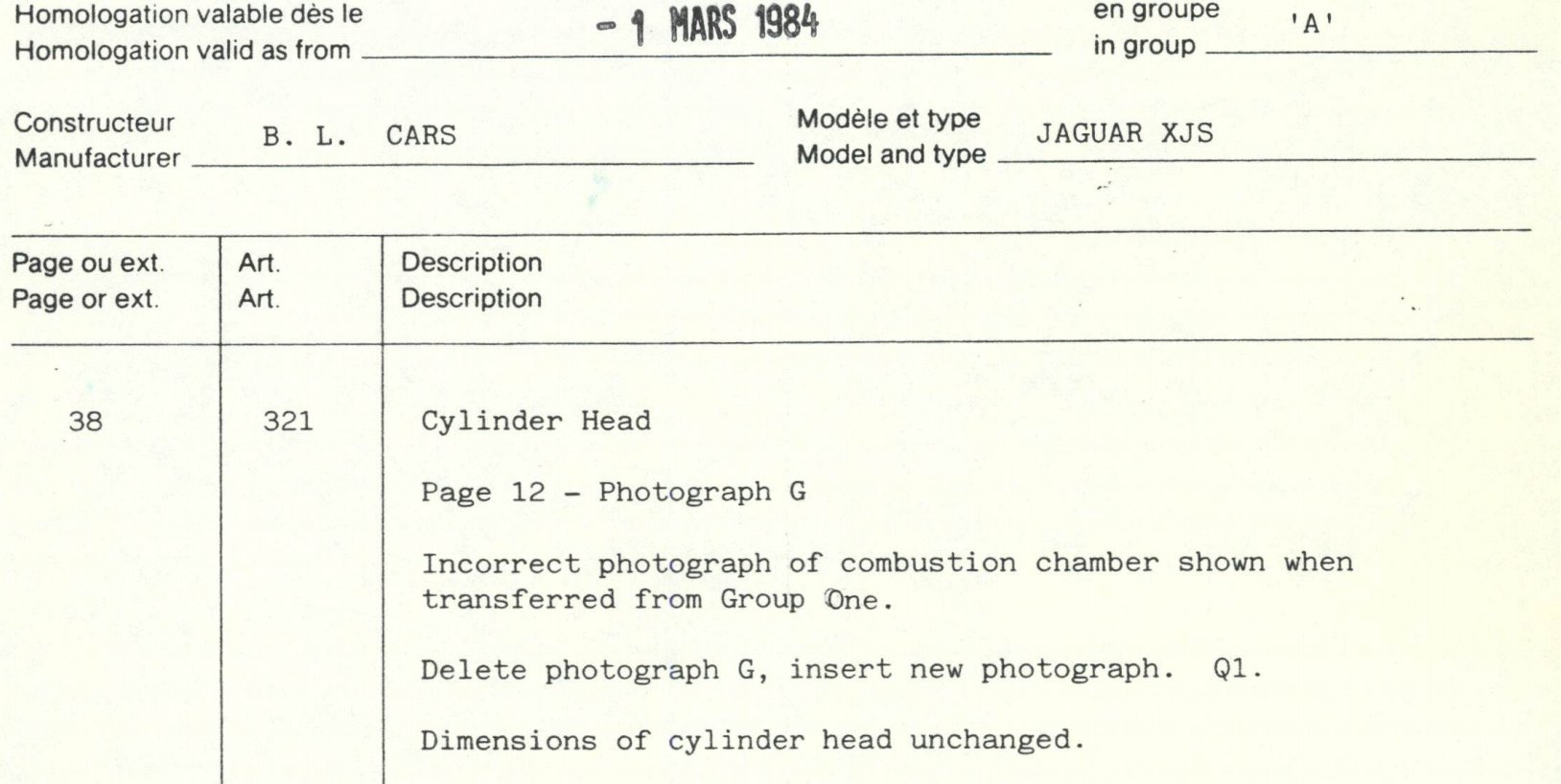levels raceway, late 80's
levels raceway, late 80's
I see Mark Petch has just purchased this car. This is not the Belgian GTM car he owned in 1985 that won the Wellington Street Race, but rather the second car that came on board in 1986 as part of the Volvo Dealer Team, and driven by John Bowe.
His Facebook posting reads:
"After a lot of investigation and negotiation I am very pleased to have been able to purchase John Bowe's GpA, Australian Touring Car Championship Volvo 240T that has been the subject matter on my timeline below.
"The car has an incredible history and is not the only surviving RAS Factory Volvo team car, but also the very last Volvo Factory "Works" GpA 240T car built. The car was assembled in Australia by the Australian Volvo Dealer Team, by key team mechanic Geoff Grech [who went on to become the Team manager at HRT] and a young fabricator, name unknown, who fabricated the first Chrome Moly roll cage ever run in a Volvo Works car in place of the Factory cars previously used Aluminium tube bolted together roll-cage.
"The car was finished only the day before the 1986 Sandown 500 Endurance race, were it DNF'd as it also did a month later at Bathurst when John was running in second place. All three AVDT cars including my own car that helped Robbie Francevic to the ATC Championship win in 1986 were returned to Sweden, when Volvo pulled out of GpA racing, In privateers hand's the car was immediately successful and dominate the 1987 Swedish Touring Car Championship driven by Peggen Andersson.
"The car went on to compete in many other races by various other drivers, including Sweden's famed Ulf Granberg. The car was purchased by Knud Knud E. Sørensen a Danish driver, who had just started to race, and against the later crop of cars such as the Ford Cosworth RS 500's it proved less than competitive. It was sold to another Danish aspiring racing driver who lived in Spain were it disappeared for 14 years, before being advertised for sale in 2009 when, Thor Rustad's a Norwegian, purchased the car and stripped it down to bare metal and commenced at 6 year long, 2,476 Hour, complete rebuild of the car to as new condition, 100% period correct to when the car was last raced by John Bowe and Alfi Costanzo at Bathurst in 1986".
Nice. Hope we can see it at the Festival in January.
Ok, I'm picking at straws here but Mark Petch is wrong, Car 44 never got to the dizzy heights of position 2. It did reach position 3 on lap 42 and then pitted falling to position 7, worked it's way up to position 6 (it was having an entertaining dice with johnson in the mustang) just before it fell away into obscurity on lap 55, thanks to the rear aluminium trailing arms failing
Here is a transcript of the Official Lap Charts, taken from Bill Tuckey's 1986 book of the race
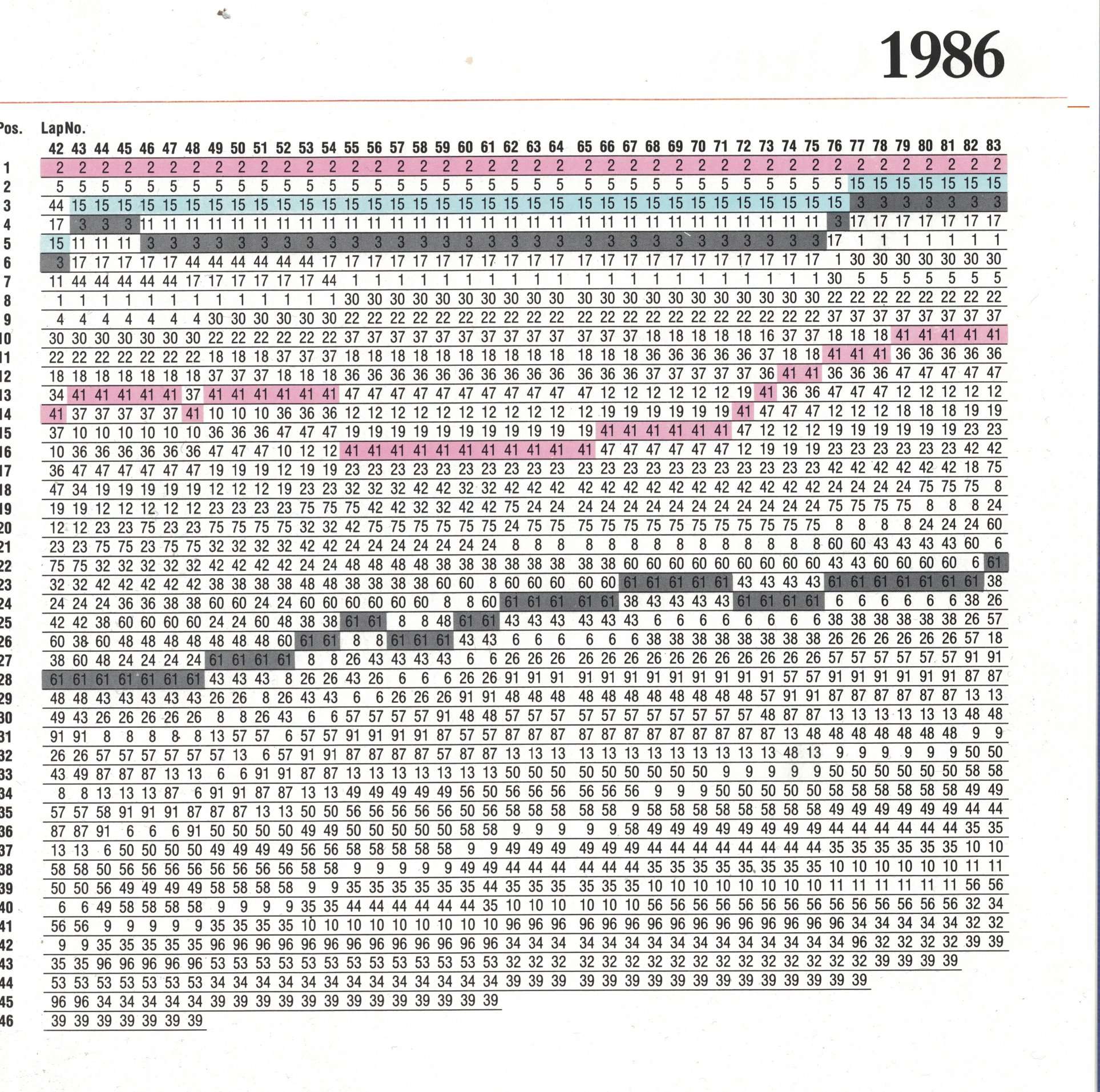
You sure that's the right chart Jim? What you typed doesn't line up with that chart. It also shows cars in positions 60, 87, 91, 96 etc. Its only a 55 car grid.
You must be reading it wrong, those are Car numbers not positions. Across is no of laps, down is position on the track. For instance, Car 2, The Chickadee Commodore, led until lap 37 where Alan Grice pitted, putting car 05 in the lead for 2 laps, then Brock pitted, putting Gary Scott in car 15 into the lead for two laps before Gricey regained the lead.
On the completion of the first lap car 44 was in position 9, where it continually climbed the leader board swapping places with Johnson in car 17 for several laps
Sorry my mistake, I thought the vertical column was car number on the left rather than race position.
An interesting piece of the history of Group A is how the cost quickly escalated. In 1984 when CAMS announced Australia would be adopting Group A for 1985, part of their reasoning was the cost would be lower and the privateers would stand a better chance. This proved to be folly. In 1984 the cost of building a good Group C commodore was between 45-60k, in 1986 the cost of building (or buying a customer car) a commodore was 80k. In 1990 when asked about the progress in building the Nissan GTR, Gibson replied "you are looking at possibly the first half a million dollar group a race car"
Here is an interesting pic, it shows just what it takes to win Bathurst in Group A. Grice went to Bathurst in 1986 with no less than FIVE spare Roadways (read Les Small) built spare engines! yes FIVE! Now you think about it, in 1986 a customer Group A engine sold for between 15-20k from the likes of the HDT, Perkins and Roadways. That's a serious investment!
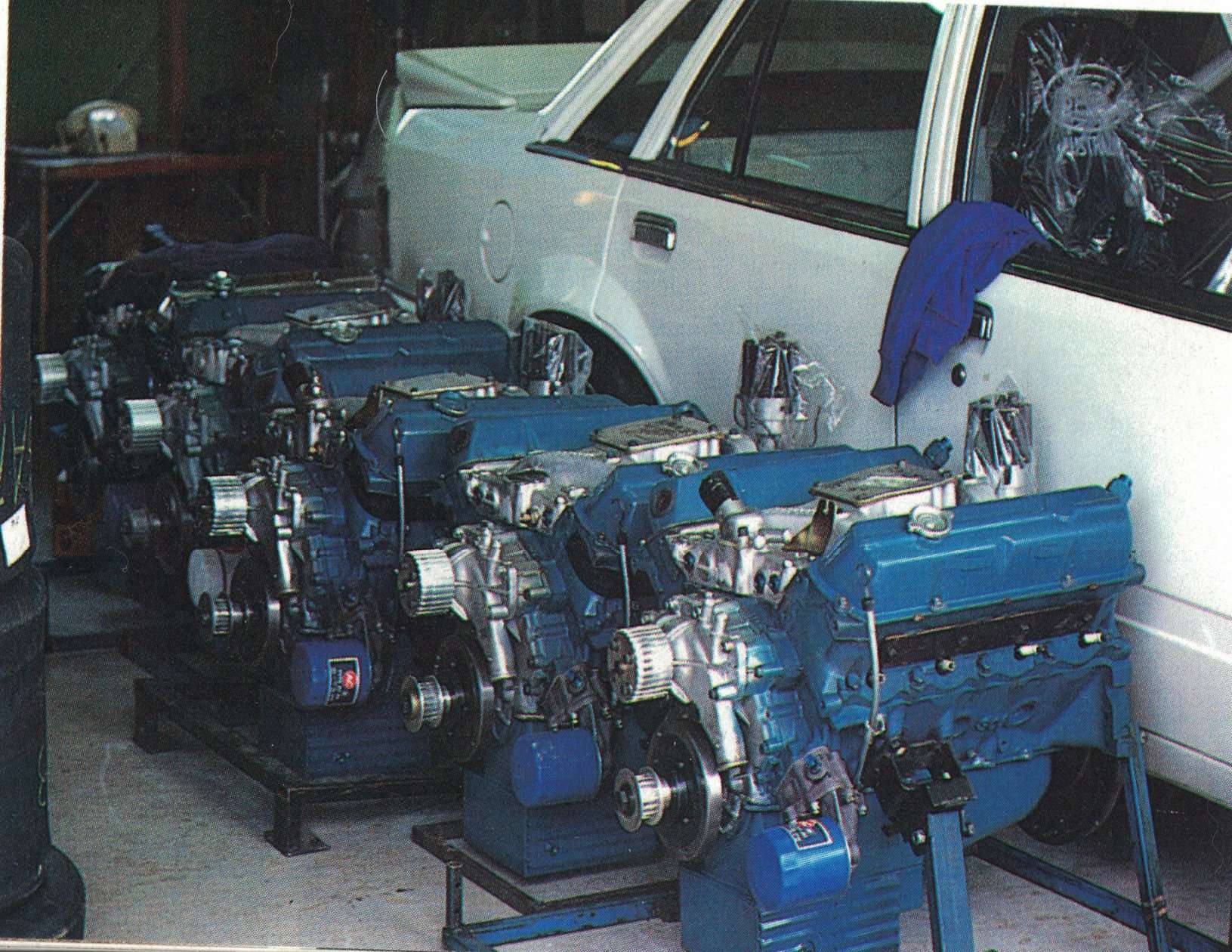
And the cost of the current cars???
millions Oldfart! Like CAMS, the founders of V8Supercars promised it was going to be cheaper and simpler than what Group A had become. That sooned turned into a farce when they started issuing "licences" to build a car/field a team, locking out the real privateers and once a year Sunday drivers. Then they became a corporation and went high tech/high media profile.
One part of the history of Group A was it was supposed to be by the book and no special favours or considerations granted, aka what was destroying Group C. Group A in Europe was a dogs dinner, all the major teams cheated, most had gentlemen agreements bewteen each other to look the other way. Australia was by the book for the first two years, who can forget the arguement in pit lane between one team and the scrutineers over whether the tyre width could be measured with the car on jacks or on the ground. technically the team was right, the tyre could be measured with no weight, but the scrutinners insisted it couldnt be, and that year that team went into hardies heroes and the race with undersized rubber. Interestingly that same race Grice stuck by his guns and ran with the tyres measured legal off the ground, but illegal on the ground, yet no protests were made and the officials did nothing. There were many interesting points of contention in group a, dozens in fact, here is one you may not have heard of. The Shell cars were a running dual actuator bypass valve on their RS500s, whereas a single actuator was homologated. The dual was from the previous Cosworth, not the RS500. Several teams protested, including the Colin Bond Caltex team. DJR successfully argued the actuator was an "accessory" and hence "free". After that decision most teams started using the dual actuator system, including Bond. But to take it to an extreme, at one major race Bond argued that the turbo was an "accessory" when his turbo rotor was picked up as non-standard in pre-scrutineering, and hence "free"! lol, the cheek!
more on how the rules were being "INTERPRETATED" (flaunted!). The FIA Group A regs stated that aerodynamic aids and body panels were not to be "adjustable". In 1989 Allan Moffat turned up at Sandown with the front bumper/spoiler visibly at a different angle to the norm. When challenged by a non sierra team, the scrutineers declared it was just differences in panel fit tolerances that could be expected from a mass produced car! Hence the Sierra teams were given a green light to flaunt the rules. The other teams quickly followed suit. It was found by angling the rear downwards downforce was slightly enhanced. It got so bad that some teams were running the bumper with the rear a good inch down from where it was supposed to be. In 1991 they started to bring the whole bumper forward as well!
Here is a pic showing at top what the bumper is supposed to look like when fitted correctly, middle how it looks "adjusted" downwards and lower "adjusted" forwards

The Petch Sierra at Pukekohe in 1990. Drivers were Brancatelli and Gravett.
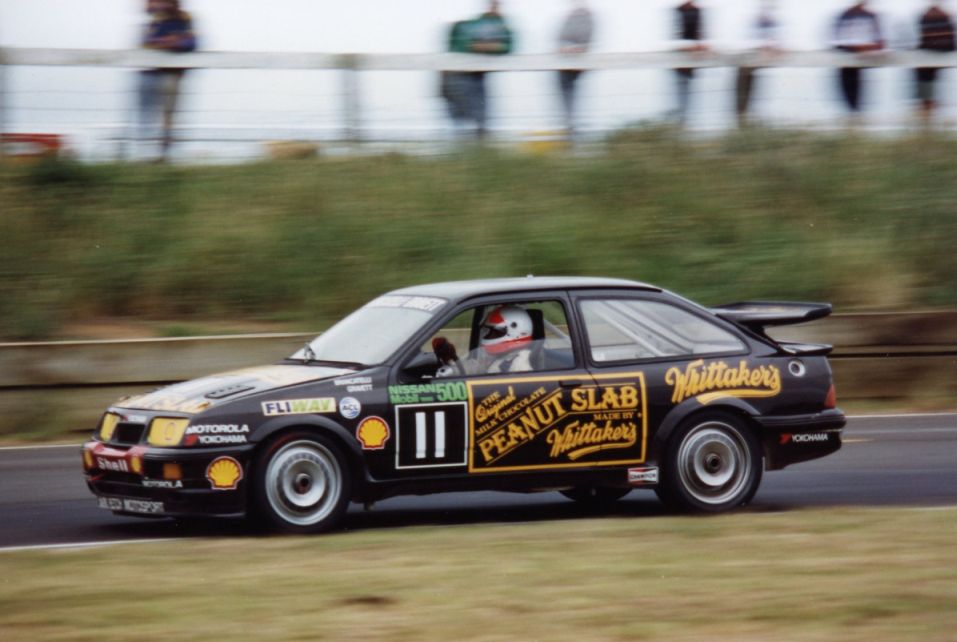
Robbie Ker, Bob Jones VL Commodore. Pukekohe 1990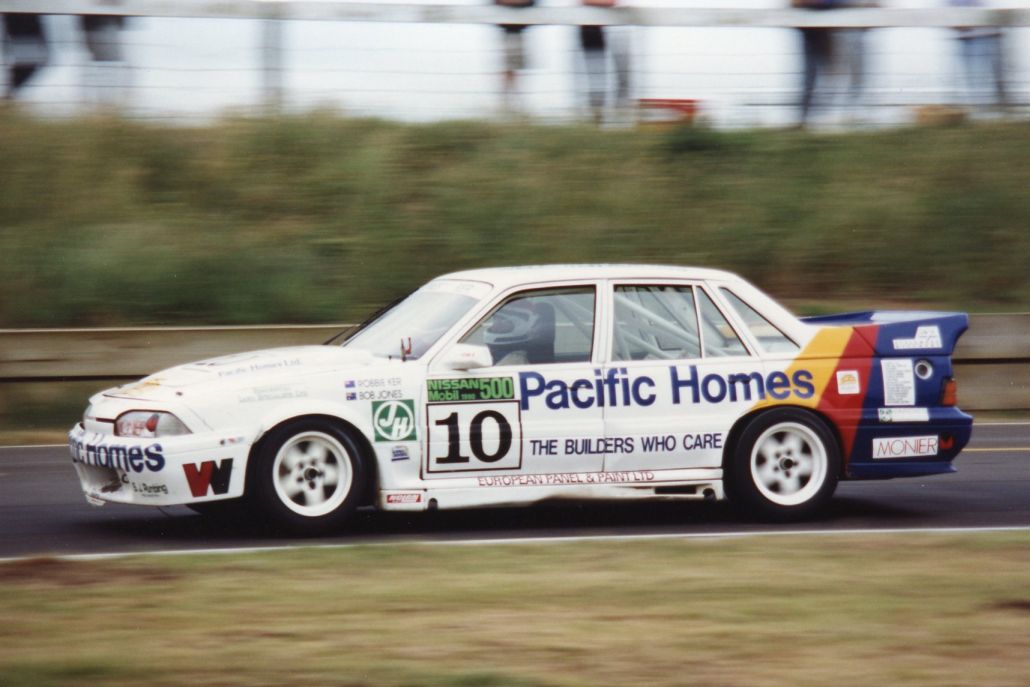
Of course, such statements helped build credibility for the amount of money he asked (and got) from the sponsors...Originally posted by jimdigris
An interesting piece of the history of Group A is how the cost quickly escalated..... In 1990 when asked about the progress in building the Nissan GTR, Gibson replied "you are looking at possibly the first half a million dollar group a race car".....
And it would approach truth if you counted in some of the overall development work on the model by the makers. To build a car, and then a second car, sees the build price come down each time.
I also agree that there must have been some pretty handsome 'fat' in the engine costs, they were fairly ordinary engines though meticulously machined and assembled.
I must admit that I never heard either of those stories, but I wasn't all that close to the game by 1986...Originally posted by jimdigris
One part of the history of Group A was it was supposed to be by the book and no special favours or considerations granted, aka what was destroying Group C. Group A in Europe was a dogs dinner, all the major teams cheated, most had gentlemen agreements bewteen each other to look the other way. Australia was by the book for the first two years, who can forget the arguement in pit lane between one team and the scrutineers over whether the tyre width could be measured with the car on jacks or on the ground. technically the team was right, the tyre could be measured with no weight, but the scrutinners insisted it couldnt be, and that year that team went into hardies heroes and the race with undersized rubber. Interestingly that same race Grice stuck by his guns and ran with the tyres measured legal off the ground, but illegal on the ground, yet no protests were made and the officials did nothing. There were many interesting points of contention in group a, dozens in fact, here is one you may not have heard of. The Shell cars were a running dual actuator bypass valve on their RS500s, whereas a single actuator was homologated. The dual was from the previous Cosworth, not the RS500. Several teams protested, including the Colin Bond Caltex team. DJR successfully argued the actuator was an "accessory" and hence "free". After that decision most teams started using the dual actuator system, including Bond. But to take it to an extreme, at one major race Bond argued that the turbo was an "accessory" when his turbo rotor was picked up as non-standard in pre-scrutineering, and hence "free"! lol, the cheek!
I was there, however, for the post-race press conference after the Eggenberger car had 'won' at Bathurst. Brock was casual, even though the 'press' pushed him hard trying to get some sort of negative comment about the fuel issue (a sample of the fuel at one stop had come up funny).
He simply got into explaining that those cars had knock sensors and it wouldn't have made any great difference to them...
Of course, the pursuit of the inner guard alteration case was carried on with vigour and they justly outed the Sierras for that. It shows that you're right about that European agreement.
Remember, too, the Masterton car with the numberplate flapping to allow more air into the radiator?
And back a bit further, I understand that at least one of the Ron Hodgson Torana A9Xs had some work done (rack location?) to reduce bump steer.
From the FIA archives in the Jaguar XJS homologation papers. They show the details when ol Tom pulled the scam of the decade homologating the pre-may type heads despite them being long out of production. "May" type heads were restrictive and designed for swirl to get better fuel consumption, great for the then fuel crisis times but not ideal for racing. When ol tom got this "erratum" through his jags jumped from 390 to 460HP. As the rules at the time said parts like heads had to be the currently fitted to the road going car how the heck did FIA rubber stamp it? Note the visible difference in combustion chamber design and the port size difference!
